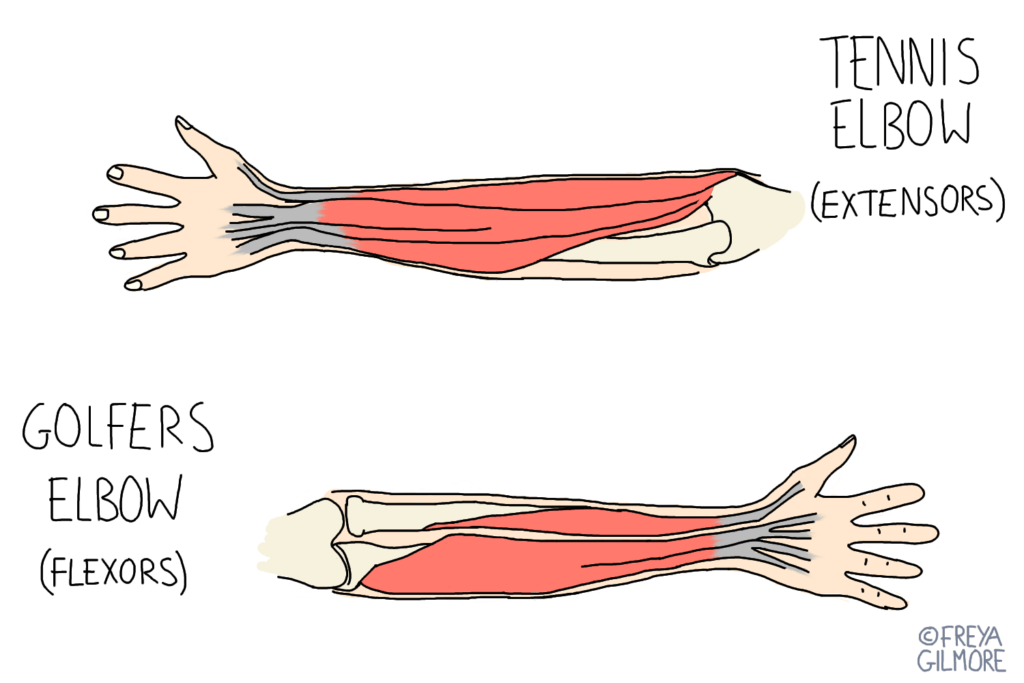Tennis Elbow, and its cousin Golfer’s Elbow, do have misleading names. Despite the suggestion, both conditions can develop without ever playing the sports they’re named after. The names allude to the movements commonly associated with tennis and golf: the wrist extension of a backhand shot in tennis, and the flexion of a golf swing. 
What is Tennis Elbow?
The technical term for tennis elbow is “lateral epicondylitis”. This refers to inflammation of part of the bone in the outer side of the elbow. The technical name is as misleading as the common name, as it is the tendon rather than the bone that is inflamed. More recently, there has been a push to rename the condition to “lateral elbow tendinopathy”, which would be a more accurate description of the problem. Tendinopathies involve microtears and inflammation within the tendon of a muscle: the pain is right up at the top of the forearm where the muscle blends into tendon before it attaches to the elbow. A tendinopathy often results from repetitive overuse, and tennis elbow is no different. Whether you’ve played a lot of tennis, badminton, or squash, or your work involves using a mouse, or vibrating tools, you can overuse the wrist extensors.
Only 5% of cases are associated with tennis, and it’s likely that more than that are associated with computer use. Ergonomic advice is usually quite general and will not suit everyone perfectly. Your osteopath can give you tailored advice. But to protect the wrist and reduce your chances of developing tennis elbow, ensure that:
- your wrist is in a neutral position when resting your hands on the mouse or keyboard
- you aren’t leaning heavily on a wrist pad, as found on some mouse mats
- your forearm is well supported by the desk
- the desk is low enough (or your chair is high enough) that you don’t have to hitch your shoulders to reach your computer
Be particularly mindful of these neutral postures when working at a laptop. Try to avoid working with your laptop on your lap, especially if you’re slouched into the sofa or bed. But when this cannot be avoided, negate the risks by taking regular breaks and considering your wrist positioning.
Golfer’s Elbow
On a micro level, golfer’s elbow is the same condition as tennis elbow, except that it affects the opposite muscle group: the wrist flexors. We see this epicondylitis much less often in clinic, possibly because modern life requires more wrist extension than flexion.
Diagnosing Golfers and Tennis Elbow
Your case history is a big piece of the puzzle for diagnosis. Pain just below the elbow, with tender muscles and potential weakness or pain on movement will point us towards diagnosis. A history of the causative factors at work or in sport as mentioned above will also suggest the tendinopathy. We also have clinical tests that we can perform in the treatment room to test the muscles and tendons and identify the cause of the pain.
If your symptoms are new and mild, you may not have a fully progressed case of epicondylitis. It may just be a muscle strain that can be managed easily to prevent the development of a tendinopathy. Acute cases can be particularly responsive to a cool compress for pain relief, but note that ice should never be applied directly to skin. Your therapist can offer more tailored advice, including exercises and lifestyle changes to support your recovery.
Management for Tennis and Golfer’s Elbow
Treating golfer’s and tennis elbow usually involves work to the affected muscles, and nearby joints. Some cases may also benefit from work through the rest of the arm and into the back, where restrictions may be demanding more of the wrist than normal.
The first step in devising a management plan for your tennis elbow pain is to understand what the root cause is. For raquet sport players, wrapping an extra grip around the handle can ease pressure on the muscles by reducing the need for such a closed grip. Desk workers may benefit from altering their ergonomics to discourage the wrist from staying extended all day. These changes are key to preventing future episodes, as well as important for minimising your current symptoms.
Stretches and strengthening exercises can work well together to relieve pain and increase resilience. Massage at home with a spiky massage ball, or even just with your hand can help to reduce symptoms too. Your therapist will give you a plan to ensure that you don’t do too much too quickly. As symptoms ease, we can also guide you in your return to sport, if applicable.
In terms of treatment, we have a range of therapies on offer at the Good Health Centre that could help.
If you suspect that you have tennis or golfer’s elbow, but don’t have a diagnosis yet, we recommend booking an osteopathy appointment so that we can investigate fully and provide a diagnosis. Depending on your case, you may then benefit from a course of treatment with your osteopath, or a combination of therapies from the list above.
Click here to make an appointment to address your aches and pains in Leeds